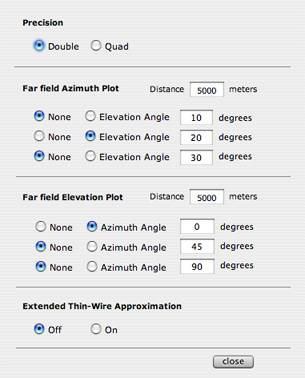In addition to passing wire geometries and other parameters to the NEC-2 engine, cocoaNEC also passes instructions for what output it wants NEC-2 to generate. You can customize this by using the Output Control sheet.
The Output Control sheet is opened by clicking on the Output Control button of the spreadsheet window.

cocoaNEC has duplicate libraries of the NEC-2 engine, one for double precision computation (64 bit floating point) and one for quad precision computation (128 bit floating point). The quad precision library is substantially slower and probably seldom needed. For most antenna models, the double precision and quad precision model yield practically identical results. The option is there in case you need to use it.
Up to three azimuth plots and three elevation plots can be generated. Notice that cocoaNEC defaults to a single azimuth plot at an elevation angle of 20 degrees and a single elevation plot for the azimuth angle of 0 degrees (the direction of the positive x axis).
By selecting the radio buttons, you can add more plots. You can also select arbitrary elevation angles for the azimuth plots and arbitrary bearings for the elevation plots. You can select a different distance (cocoaNEC defaults to 5 km) the field is computed at.
Finally, you can choose to use the extended thin-wire approximation rather than the standard, and faster, approximation. The standard approximation becomes inaccurate when a wire segment is shorter than about 8 times the wire's radius.